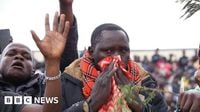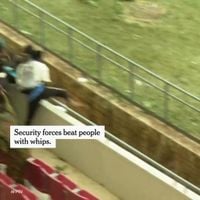The death of Raila Odinga, Kenya’s former prime minister and a towering figure in the nation’s political landscape, has sparked an outpouring of grief and, tragically, deadly violence in Nairobi. At least three—and possibly four—people lost their lives and scores more were injured on Thursday, October 16, 2025, as police fired gunshots and tear gas to disperse the massive crowds of mourners gathered at the Moi International Sports Centre in Kasarani. According to BBC and Reuters, the violence unfolded as thousands of Kenyans, united in grief and reverence, struggled to bid farewell to a leader many saw as the father of modern democracy in their country.
Odinga, who died at the age of 80 on Wednesday, October 15, 2025, in India where he had been receiving medical treatment, was mourned by supporters from across Kenya’s social and political spectrum. His death marked the end of an era for a man who, over decades, was at the center of Kenya’s political life—often as the main opposition voice, sometimes as a power broker, and always as a symbol of the struggle for multi-party democracy.
As news of his passing spread, the Kenyan government declared a seven-day period of mourning. President William Ruto went further, announcing Friday, October 17, as a national holiday in Odinga’s honor and promising a state funeral with full military honors on Sunday, October 19, at Odinga’s family home in Bondo. The significance of these gestures was not lost on many, who saw them as a rare moment of unity in a nation often divided by politics and ethnicity.
But that unity was tested almost immediately. The chaos began early Thursday morning when Odinga’s body arrived at Nairobi’s Jomo Kenyatta International Airport. According to BBC, authorities were forced to suspend flights for about two hours as thousands of mourners, determined to pay their last respects, overwhelmed airport security. Some even managed to climb the stairs of stationary planes in a desperate attempt to confirm the identity of the man in the casket. “We want to see Baba, how do we know it’s him in the casket? Let them show us and we’ll be contented,” said William Otieno Adoyo, a motorcycle rider and self-described “Baba die-hard,” using Odinga’s popular nickname.
The airport was just the beginning. From there, a slow, emotional procession snaked through Nairobi’s streets, with supporters waving branches and palm fronds—a Luo tradition symbolizing unity and mourning. The crowds, carrying candles and singing liberation songs, escorted the hearse for nearly 10 kilometers (about six miles) to the Kasarani stadium. The public viewing, originally scheduled for Parliament, had to be moved to the stadium to accommodate the unexpectedly large throng.
It was at Kasarani that tragedy struck. As Odinga’s convoy arrived, the stadium was already overflowing, with thousands more waiting outside. According to both Vocal Africa and BBC, a large crowd breached one of the gates, prompting security forces to respond with tear gas and, reportedly, live gunfire. The panic that ensued saw masses of mourners rushing towards the exits, and, as BBC reporters witnessed, men in civilian clothing beating protesters with batons.
“We can confirm that by the end of the day, our officers who were stationed at the Nairobi Funeral Home, also known as City Mortuary, saw three bodies brought in with gunshot wounds,” Hussein Khalid, CEO of Vocal Africa, told BBC. Local media reported a possible fourth fatality. Social media was soon flooded with images of the victims, and witnesses described scenes of panic as gunfire rang out and people were trampled in the chaos. The violence left dozens more injured, underscoring, as Reuters put it, the fragile dynamics of public gatherings in Nairobi and the deep passion Odinga inspired.
Despite the turmoil, the official ceremonies continued. After order was restored, dignitaries and government officials, including President Ruto, were able to pay their respects at the coffin before the public viewing resumed for a few hours. Deputy President Kithure Kindiki, who chaired the funeral planning committee, held a press briefing Thursday evening but made no mention of the deaths or the earlier chaos—a silence that some mourners found frustrating.
As the sun set over Nairobi, thousands lingered at the stadium and other public sites, refusing to let violence overshadow their grief. Police, meanwhile, stepped up patrols across the capital, wary of further unrest as the mourning period continued.
The next steps in Odinga’s final journey are already set. On Saturday, October 18, his body will be transported to Kisumu, the lakeside city that is his political stronghold and home to many from his Luo community. There, members of the public will have another opportunity to pay their respects before the burial at his farm in Bondo, about 60 kilometers west of Kisumu, on Sunday. According to his family, Odinga had wished to be laid to rest within 72 hours—a request that speaks to both tradition and his character, always moving forward, never lingering in the past.
Odinga’s passing is more than just the loss of a political leader. For many, it is the loss of a father figure, a symbol of resilience and hope. “He fought tirelessly for multi-party democracy, and we are enjoying those freedoms today because of his struggle,” university student Felix Ambani Uneck told Reuters at the stadium. The sentiment was echoed by countless others, some of whom had not even been born when Kenya transitioned to multi-party democracy in 1991, but who grew up hearing stories of Odinga’s sacrifices and determination.
Odinga’s legacy is complicated, as any true statesman’s must be. He was a five-time presidential candidate who never won the highest office, often claiming electoral fraud as the reason for his defeats. He was at times a political prisoner, at others a power broker—serving as prime minister in 2008 and forging a surprising pact with President Ruto last year. But through it all, he remained a champion for democratic ideals, especially for the marginalized and the voiceless.
As Kenya enters this period of mourning, the country faces not just the challenge of saying goodbye to a beloved leader, but also of confronting the divisions and tensions that his life and death have laid bare. The scenes at the airport and stadium—of unity and chaos, reverence and violence—are a stark reminder of both the power and the peril of collective grief. Yet, as the crowds continue to gather, waving branches and singing songs of freedom, it is clear that Odinga’s spirit endures in the hearts of millions. His story, and the story of the country he helped shape, is far from over.

